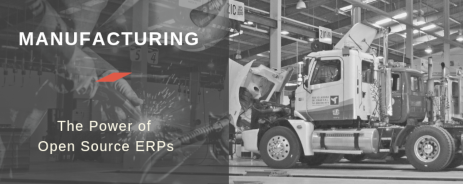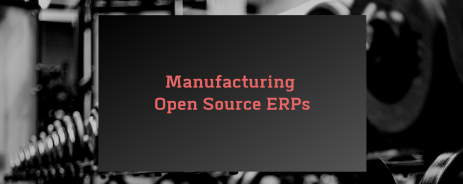
American Manufacturers Leverage the Power of Open Source ERPs
Open source enterprise resource planning (ERP) solutions can dramatically affect the way a business operates, but for many manufacturers, the benefits of ERPs seem somewhat elusive. At Blue Stingray, we’ve handled ERP projects for a number of Fortune 500 companies, including Kohler, Pepsi, and TransAmerica, and we’ve seen significant advantages in open source platforms.
In fact, across every industry, companies are starting to realize how powerful and cost-effective open source software can be. Industry leaders like Microsoft and SAP already use open source initiatives. With the introduction of the Department of Defense’s Open Source project, Code.mil, these tools are rapidly going mainstream.
Toyota, Hyundai, and Allied Steel all depend on an open source ERP to run divisions of their daily processes. Blue Stingray specializes in helping companies of all sizes migrate to better, more affordable systems, by using the power of open source software.
In this piece, we’ll discuss that power — and hopefully, help manufacturers find better ways to use open source ERPs to optimize their operations.
Defining the Open Source ERP
This prompts an obvious question: What is an open source ERP, anyway?
Enterprise resource planning systems — ERPs — are suites of applications that manage and organize every aspect of a business’s operations. Open source ERPs have open source code, which allows developers to work directly with the system to create (and even market) improvements, add-ons, and extensions tailored to different types of businesses.
A quick note on the word “enterprise:” It’s often misinterpreted to mean “large global businesses,” but “enterprise” in this context refers to any business entity that relies on more than one process to run its operations. ERPs include software for every department, including accounting, inventory, sales, manufacturing planning, and maintenance. ERPs store all company data in one database, which allows users to track internal processes on a daily (or even hourly) basis.
How Legacy ERPs Cause Problems for Manufacturers
Up until recently, the leading legacy ERPs required millions of dollars to successfully implement. Only corporations with large budgets could afford them. Mid-level manufacturing companies were forced to simulate ERP environments through the use of several independent software solutions.
This caused some serious problems. These standalone solutions were rarely connected, so they required extensive manual user input to stay in sync. When business operations grew in both quantity and complexity, the amount of incorrect data would become a serious issue.
Ultimately, the goal of an ERP is to replace multiple independent systems and to assist with sophisticated processes like manufacturing planning. When applications are connected to a single database, an ERP not only ensures data consistency and integrity, but also the data’s real-time availability. As system updates are made throughout the company, they instantaneously become available to every department, which keeps all teams in sync.
To Be Effective, A Manufacturing ERP Needs To Be Flexible
For modern manufacturers, the flexibility of an ERP is just as important as the platform’s out-of-the-box features.
Traditional ERPs offer a massive suite of features, and hope that those features will work for every company. That approach results in high cost due to an overabundance of unnecessary features — many of which are never used. These out-of-the-box systems offered little to no flexibility, requiring businesses to adjust their operations to match the ERP.
With the emergence of open source ERPs, the manufacturing landscape has drastically changed. Aside from their lower cost, open source ERPs offer full flexibility and scalability; they can support the abrupt internal operations changes that small- and medium-sized businesses often need to implement. Legacy systems require companies to change their processes, while open source ERPs change based on the needs and requirements of the company.
Perhaps most importantly, open source means the system is ‘available’ — available for modification, available for customization, and available (and affordable) to businesses of any size.
A sophisticated open source ERP like Odoo is capable of handling the most robust manufacturing operations. Odoo is capable of transforming itself based on the market requirements, and it integrates well with new technologies like IoT and robotics.
Here are some of the key features open source Odoo ERP platform offers to manufacturers:
- Multi-level Bill of Materials – create a Bill of Materials (BOM) within existing BOM. In this way, manufacturers are able to keep track of materials used in the production of final products.
- Manufacturing Orders or Work Orders – start and manage production via Manufacturing Orders or Work Orders. Use Work Orders to manage the production of products needed for the final assembly.
- Edit Manufacturing Orders – edit original Manufacturing Orders and change the order of actions on the go.
- Schedule and Plan Manufacturing – use the Scheduling view to easily view, schedule, and reschedule manufacturing operations.
- Bill of Materials Management – easily track which items are available for use in production.
- Flexible Routing – create and manage your own routings.
- Document Management – attach worksheets and documents to Bill of Materials and routings.
- Quality Control – schedule and manage quality checkpoints within the manufacturing process.
- Kanban Quality Alerts – use Kanban view to manage quality alerts.
- Mobile Equipment – use tablets to organize and manage work center processes.
- Easily Accessible Worksheets – provide work center operators with easy access to worksheets that contain instructions.
- Kits – provide a quick way of purchasing a set of products that usually go together. Your clients will be able to purchase kits, which will be delivered as a set of products.
- Repairs – easily manage all equipment repairs.
- Product Changes – keep track and allow for changes in versions of products and materials used in BOMs.
- Maintenance – automatically schedule maintenance of equipment. Use the calendar for easier scheduling.
- Miscellaneous Operations – manage all of the miscellaneous operations (scrapping, alerts, checks) directly from the work center.
Those are just some of the key manufacturing features open source ERP Odoo provides. Again, the key reason to use an open source platform is flexibility — if your business has a unique workflow, if you rely on more than one applications for your day-to-day operations, or if you’re simply looking to improve efficiency while centralizing data collection, an open source platform like Odoo can make an enormous difference.
If you are interested in learning more about this platform, contact us for a free demo and consultation.




